New Laser Testing System Brings NIF Back to the Future
July 28, 2021
NIF has reached back to its past to advance toward its future.
The facility has recommissioned the Precision Diagnostic System (PDS) as a more comprehensive version of the PDS that was decommissioned after the initial design of NIF’s laser system was completed in 2007.
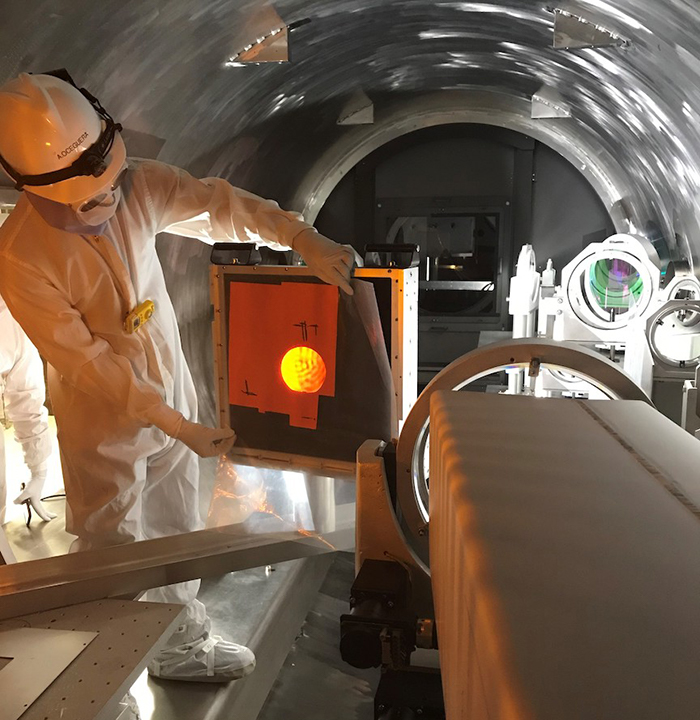
The new PDS has an advanced array of diagnostic tools that help researchers experiment with potential methods to increase laser performance without risking the main systems.
“We can test the limits of the power and the energy that we can operate this laser at,” said Steven Yang, leader of the BeamLine Integrated Performance (BLIP) group and co-leader of the Laser-Alignment System Engineering (LASE) group. “It’s uniquely suited for trying out different things that push the envelope of the laser.”
PDS System Engineering Manager Simon Cohen, the integrated project team (IPT) lead, said the PDS can “acquire snapshots of the laser near-field image in the nanosecond time regime that provide significant opportunities to analyze the laser as never before.”
NIF is the world’s largest and most energetic laser system, with 192 laser beams precisely guided and focused onto a target the size of a pencil eraser for a few billionths of a second.
Numerous diagnostics are available to characterize the performance of each beam long before it reaches the target inside NIF’s Target Chamber. Laser physicists, however, wanted to better understand how the beams were performing at a critical juncture inside the Target Chamber after frequency conversion crystals changed their wavelength from 1-omega (infrared) to 3-omega (ultraviolet).
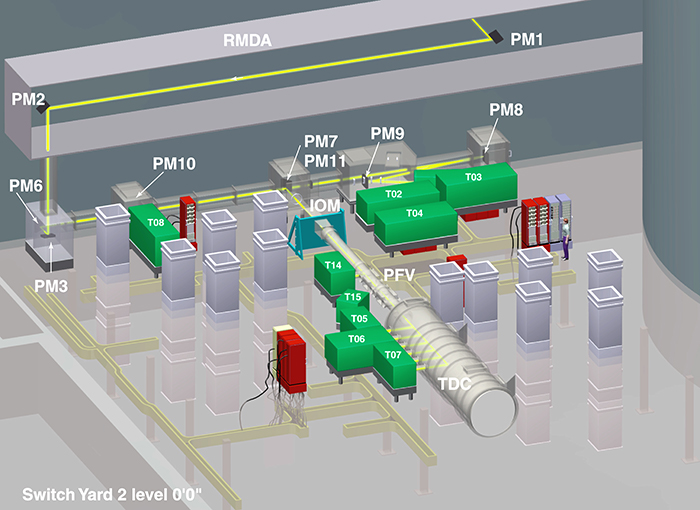 This graphic shows the PDS layout, with a series of pickoff mirrors (PM) directing a beam toward the PDS integrated optics module (IOM) and then to the cylindrical TDC, as well as many diagnostic tables (in green).
This graphic shows the PDS layout, with a series of pickoff mirrors (PM) directing a beam toward the PDS integrated optics module (IOM) and then to the cylindrical TDC, as well as many diagnostic tables (in green). “NIF has really good laser diagnostics on the front end, but it only has a couple of basic diagnostics at the Target Chamber,” said Jim Folta, who was the PDS project manager until his retirement in March. “So there’s a lot of laser performance data that we cannot measure once you get to the Target Bay. And that’s where one of the most important parts of the laser operation occurs, when we convert the beam from infrared to ultraviolet.”
Trying to drive NIF to higher energies and powers could damage optics in the Target Bay, which also doesn’t have room for the laser diagnostics required. The self-contained PDS “is exactly the right place to do that,” Folta said. “PDS is not about shooting targets. PDS is about measuring the laser performance.”
NIF is the size of three football fields. The PDS takes up an area roughly the size of two tennis courts inside Switchyard 2—one of NIF’s two laser switchyards—between Laser Bay 2 and the Target Chamber. Each switchyard directs 96 beams to individual integrated optics modules (IOMs) that convert lasers from 1-omega to 3-omega before they enter the Target Chamber.
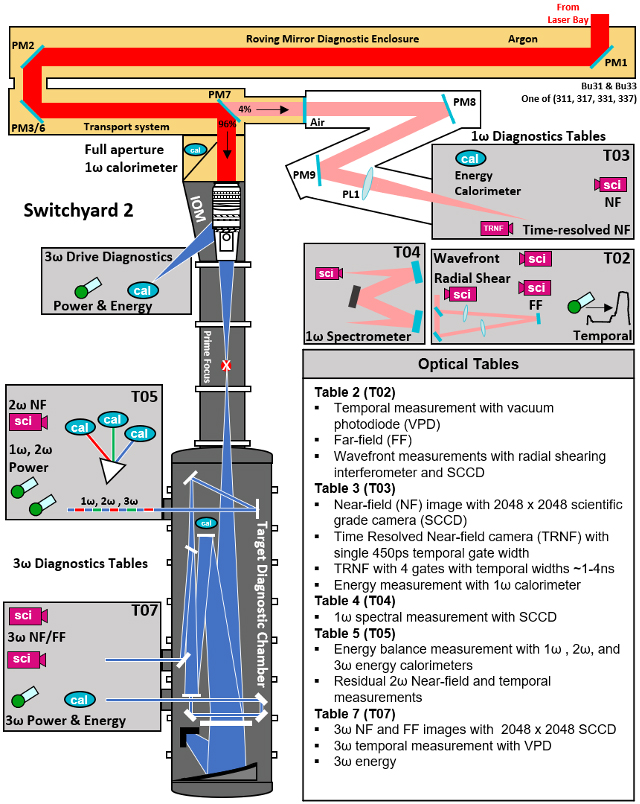
The PDS is currently designed to diagnose one of four specific NIF beams. Light from Laser Bay 2 enters a roving mirror diagnostic enclosure (RMDE), where a motorized mirror redirects the selected beam into a series of other transport mirrors that further directs it into the PDS.
One mirror transmits 4 percent of the light to a series of 1-omega diagnostic tables featuring instruments such as an energy calorimeter and a spectrometer. The other 96 percent of the beam is reflected toward the PDS’s own IOM, with conversion crystals and a grating debris shields just like the IOMs inside each of the 48 final optics assemblies attached to the Target Chamber.
“One of the unique features is the fact that we have this long cylindrical vacuum tank where we are able to focus the NIF laser beam just as we do in the Target Chamber,” Yang said. “We’re able to diagnose very precisely what’s happening at the laser focus and what the laser parameters are like.”
Each NIF IOM focuses the 3-omega laser on a target, and “the PDS IOM focuses the laser in the same way,” Cohen said. “But instead of a target at prime focus, the light then expands into the PDS Target Diagnostics Chamber, an enclosed vacuum vessel that relays the laser to other diagnostic tables for evaluation of the 3-omega light’s energy, power, and near-field and far-field image. There are also numerous diagnostics of the unconverted light at 1-omega and 2-omega wavelengths.”
The PDS even has its own final optics damage inspection (FODI) camera, which peers back down the beamline to detect laser-induced optical damage, just as it does in the main NIF system.
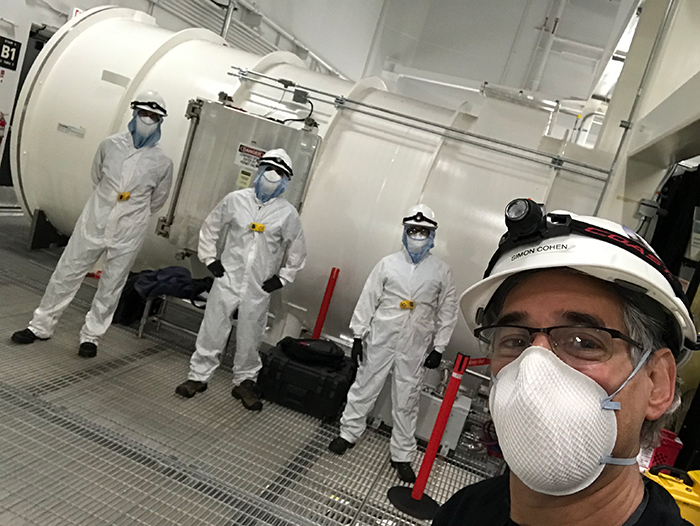 PDS team members standing outside the TDC are (from left) Abe Handler, Anthony Oceguera, Mario Ordonez, and Simon Cohen. Not shown: Catalin Filip. Credit: Simon Cohen.
PDS team members standing outside the TDC are (from left) Abe Handler, Anthony Oceguera, Mario Ordonez, and Simon Cohen. Not shown: Catalin Filip. Credit: Simon Cohen. The original PDS operated from 2003 to 2007 as a testbed to evaluate the frequency conversion performance of the FOAs. Those tests were needed to allow NIF to start high-energy-density science experiments in 2009.
But diagnostic devices have advanced quite a bit since those early days. One example is the ultrafast, multi-frame x-ray camera system known as the Icarus2 developed at Sandia National Laboratories (see “Icarus Camera Soars Close to NIF’s Sun—and Thrives!”).
The PDS’s deployment of Icarus2 captures 2D gated nearfield images in four frames during a 17-kilojoule, 17-nanosecond pulsed system shot at 1 omega to measure spatial and temporal distortions encountered at the damage threshold of optics, as measured by a metric known as the B-integral.
Previously deployed for NIF’s high-neutron-yield inertial confinement fusion (ICF) experiments, Icarus2 is being used for the first time in the PDS “to slice and dice the electric field and better understand spatial-temporal couplings that are happening at high B-integral,” said research scientist Jean-Michel Di Nicola, NIF chief engineer for laser systems and NIF Power and Energy integrated product team lead.
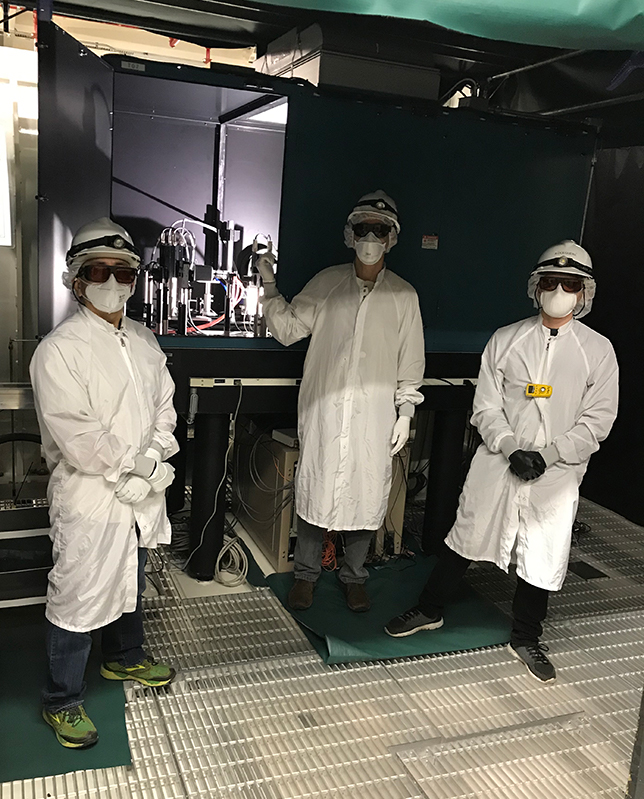
Optics filamentation damage—angel hair-like fractures running through the optic—appears to be caused by B-integral-induced intensification at the edge of beams, a phenomenon that has been under-predicted by simulation models, Di Nicola said.
NIF has been able to demonstrate the capabilities of higher performance, but determining the levels that avoid filamentation has proven to be “elusive and beamline dependent,” Di Nicola said. “It’s also difficult to diagnose when we are firing at Target Chamber center because of the lack of detailed diagnostics deployed in standard operations.”
That’s one reason NIF decided to recommission the PDS. “It allows us to perform full energy and full power beam characterization experiments and increase our understanding of B-integral effects,” he said (see “New Ways to Diagnose NIF Laser Performance Outlined at Photonics West”).
Recommissioning the PDS took more than three years. Various NIF operations teams had a hand in the project, including Facilities and Infrastructure Systems, Integrated Computer Control System, Safety Interlock System, and Optics and Materials.
Yang’s team will maintain and operate the PDS, which provides him with an interesting career bookend.
“I was the last person who ran PDS before it shut down 14 years ago,” he said. “I was the person who turned out the lights.”
Folta was thrilled to help NIF plan ahead before he retired.
“This is our investment in the future,” he said. “This is a key enabling technology, a key capability that builds on our pathway to ignition.”
—Benny Evangelista
Follow us on Twitter: @lasers_llnl



